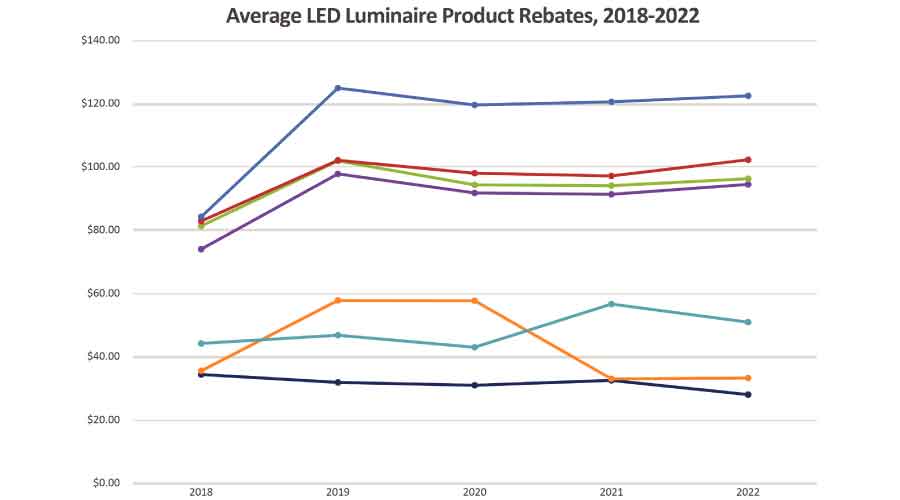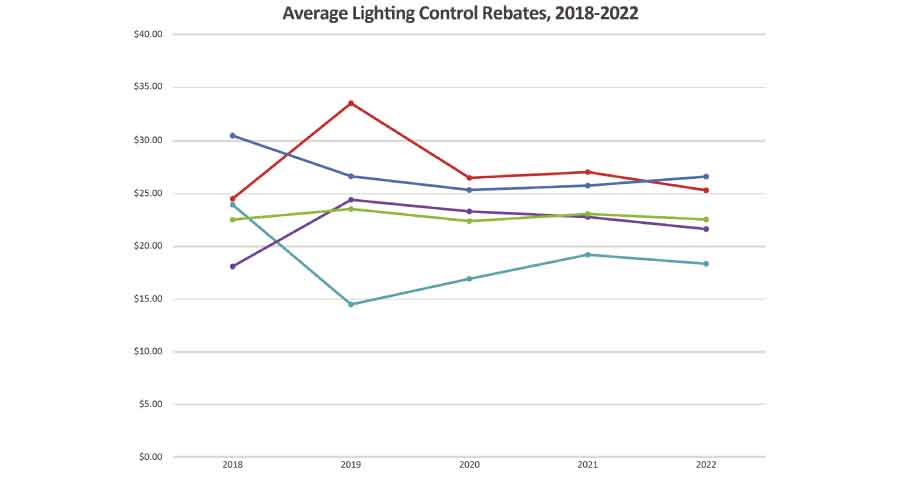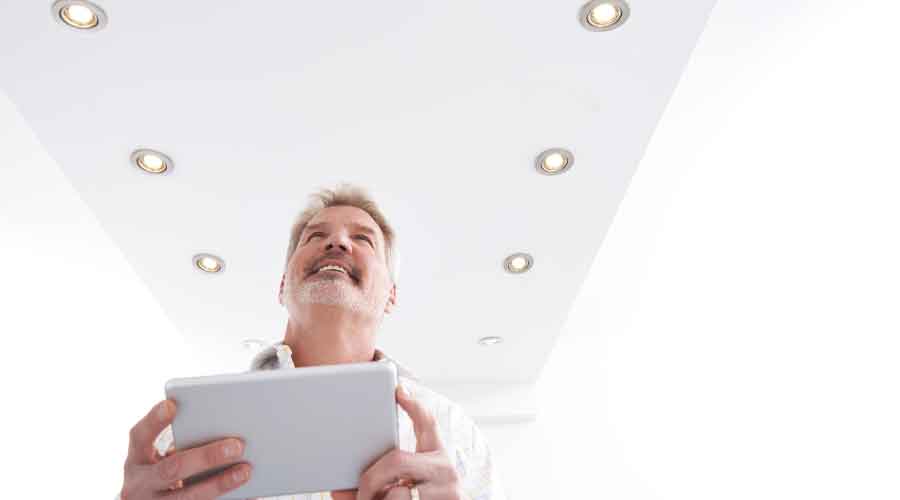Commercial Lighting Rebates Evolve
A growing portion of rebate programs now recognize networked lighting control systems. Here’s how to take advantage.
By Craig DiLouie, contributing writer
“Money on the table.”
That’s how utility rebates are often described. This enduring and widely available form of utility demand-side management policy offers cash incentives to install equipment that reduces ongoing energy costs. By encouraging its customers to reduce energy consumption, the utility can defer construction of more costly power capacity while offering a beneficial service.
But money on the table is only part of the story. What rebates really are is a means to lighting modernization and its energy cost-savings and other benefits. The upgrade may treat lighting as a commodity and seek purely to reduce its cost. Or it may treat lighting as an asset and seek to optimize it to enhance operations.
Either way, the rebate addresses one of the most significant barriers to upgrading obsolete lighting systems, which is initial cost.
Like everything else in the world of lighting, rebates are changing, with new opportunities to take an upgrade much farther than the old paradigm of changing out components. Some on the lighting side, most dealing with incorporating state-of-the-art lighting control.
This article provides a snapshot of the rebate offering in 2022, identifies trends such as networked lighting controls, and offers guidance on gaining rebates.
Types of rebates
Commercial lighting rebates vary in approach, but generally they fall into one of three types.
- 1.) Prescriptive (downstream) rebates are the most common type. These rebates are earned for approved projects as a cash amount per qualifying energy-efficient product that is installed. Fairly straightforward, though the process may require an upfront investment, pre-approval, and inspection.
- 2.) Point of sale (midstream) rebates are far less available and typically limited to very common lamps and in some cases common luminaires. In this case, the rebate occurs at the point of sale, resulting in an instant, relatively low-risk rebate.
- 3.) Custom rebates are for projects that go beyond the prescriptive program, relatively complex but with potentially substantial rewards. The rebate may be based on $/kWh savings. In this case, the project team is essentially proposing a rebate to the utility for an innovative project.
Lighting controls are a best fit with prescriptive and custom rebates. Due to their common appeal, this article will focus on prescriptive rebates.
Lighting and control rebate trends
Commercial lighting rebates have evolved to a point where the principal illumination technology is LED. This offers substantial energy cost savings and expanded choice, with options such as color tuning, greater controllability, and field adjustability, to name a few. Installing luminaires instead of components provides opportunities to update the lighting design and functionality in addition to improving efficiency.
The first LED product rebates were significant, though average rebate amounts declined to reflect falling costs in the market. In recent years, LED rebates have generally stabilized and cover a wide range of product types and applications, as shown in Figure 1. Another significant development has been an increase in horticultural LED rebates, which themselves are becoming more standardized with prescriptive rather than custom rebates.
Figure 1: Popular LED luminaire categories featured in prescriptive commercial lighting rebate programs in 2018 through 2022, with average rebate amounts per product for programs in the U.S. and Canada. Source: BriteSwitch RebatePro North American rebate database, February 2022.

Third are lighting controls. In new construction, lighting controls are typically treated as an integral part of lighting design due to commercial building energy codes. In an existing building, they are often treated as an add-on to a lighting upgrade, as combining installation is more economical.
The case for including lighting controls is simple and compelling: Automating the lighting system to operate only when it’s needed reduces waste and optimizes energy savings. As the majority of LED products are inherently controllable, greater savings and occupant satisfaction can be realized by reducing rather than switching lighting and by giving occupants the ability to adjust light levels.
The good news is lighting control rebates historically have remained consistent and robust, as shown in Figure 2, as well as widely geographically available. These rebates cover remote, wallbox, and luminaire-mounted occupancy sensors and daylight-responsive controls — staples in newer buildings. Wireless communication enables installation of remote devices without dedicated control wiring, which simplifies installation in existing buildings. Because average rebate dollars can be significant compared to cost, these control solutions can offer an attractive upfront add-on for an LED lighting upgrade.
Figure 2: Popular lighting control categories featured in majority of prescriptive commercial lighting rebate programs in 2018 through 2022, with average rebate amounts per product for programs in the U.S. and Canada. Networked control systems are not included, as programs are currently unstandardized. Source: BriteSwitch RebatePro North American rebate database, February 2022.

As mentioned earlier, lighting controls are traditionally included in lighting upgrade projects as an add-on, with simple devices such as occupancy sensors typically being favored. Technology has advanced, however, such that highly sophisticated control systems are now accessible to existing buildings, not only maximizing energy savings but providing other potential capabilities such as measuring and monitoring.
One of the big trends in commercial lighting rebates is that a substantial and growing portion of rebate programs now recognize these networked lighting control systems.
Networked lighting control rebates
Networked lighting controls (NLCs) are intelligent (computing-based) systems in which devices communicate within a network to enact control strategies. On the network, each control point is assigned its own unique address, which can be used to designate control strategies and schedules individually or in groups. According to a study of NLC installations at more than 100 applications by the DesignLights Consortium (DLC), these systems generated an average 47 percent energy savings.
NLCs can be desirable for layered control strategies, software-based zoning and rezoning, and simplified wired or wireless connection. Typically, they offer at a minimum the capabilities of continuous dimming, occupancy sensing, daylight response, and high-end trim. Depending on the system, other capabilities include scheduling, luminaire-level lighting control, device monitoring/remote diagnostics, plug load control, scene control, and color tuning.
In medium and smaller projects, NLCs are often installed at the room level. In larger buildings, they can tie together for global control by a skilled operator and potentially integrate with other building systems. This is where things get really interesting, as the building owner gains the ability to collect occupancy, daylight, and potentially other data such as temperature and humidity, in some cases from the same sensor. The data feeds to the Cloud or a server for analysis using software, allowing building owners and managers deep insights into energy consumption, how spaces are utilized, and more.
Years ago, converting an existing lighting system to a state-of-the-art lighting and control system with at some use of the Internet of Things would have been considered unlikely for a majority of buildings. Since then, technology has advanced such that it is far more accessible.
Now even more so, thanks to rebates.
Traditionally, rebate programs treated NLC as a custom rebate option, but several years ago, some programs began introducing prescriptive NLC rebates. By 2022, they grew to include more than one-fourth of prescriptive rebate programs. As this type of rebate is relatively new, programs are still experimenting with approaches, though the most common is a simple rebate adder per luminaire connected to a qualifying NLC. Where a specific prescriptive rebate is not available, networked lighting controls may be eligible for a custom rebate.
Getting the rebate
Prescriptive rebates present an attractive means to reduce initial cost and improve payback and return on investment for a lighting and controls upgrade. The acquisition process takes time and requires administrative resources, however, which may be outsourced to a rebate fulfillment firm.
Here are some tips for best results:
- Learn about rebate availability. To determine rebate availability in your area, contact local utilities and energy efficiency organizations. Alternately, some manufacturers offer rebate search tools.
- Learn the program. Because rebate programs are not standardized, vary widely, and can change, it can be beneficial to become educated about detailed program requirements such as design specifics, pre-approval requirements, product qualification, inspections, expiration dates, and so on.
- Manage risk. There may be cases of a rebate not being approved, awarding a smaller amount than planned, or being temporarily discontinued. Some rebate programs have a “reservation of funds” policy, which reserves funds for approved projects working their way through the process. It is also advisable to stay up to date on any changing program requirements.
- Gain pre-approval if needed. The majority of rebate programs require application and pre-approval prior to installation. During this step, the rebate program may ask for information such as a description of the existing lighting installation, building area, hours of operation, etc. Build this time into the project and ensure the paperwork is done correctly to avoid delays.
- Select qualified products. Rebate programs typically involve proposal for installation of energy-efficient products that are considered eligible for the rebate through qualification. These qualifications are typically third party in the case of lamps and luminaires: ENERGY STAR (lamps) and the DLC’s Qualified Products Lists (QPLs) (lamps, retrofit kits, luminaires, networked lighting controls).
The DLC maintains QPLs for solid-state lighting (SSL) products, horticultural LED products, and networked lighting controls (NLCs). These QPLs provide a valuable tool for identifying and evaluating products with or without a rebate. Standard lighting controls such as standalone occupancy sensors do not require listing. In the DLC QPLs, each product carries a unique identifier to make it easier to verify its qualification.
The SSL QPL is currently transitioning to Version 5.1, which added requirements for spectral quality and light distribution in addition to dimmability for a broad range of products. Version 2.1 of the horticultural technical requirements recently went into effect, recognizing three new product types. LUNA Version 1.0 recently launched as an SSL QPL subset to recognize outdoor LED luminaires that satisfy SSL Version 5.1 while also achieving added criteria aimed at minimizing light pollution. And the NLC QPL is transitioning to NLC5, which requires compliance with one of several cybersecurity standards and requires energy monitoring if the system is not a room-based system.
- Inspection may be required. Onsite (or virtual) inspection may be required to verify installation of the products. Some documentation detailing the installation may be required. Some programs may require measuring and monitoring to capture and validate energy savings.
- Payment may take some time. Note it can take weeks or even months of administrative processing time to receive a rebate check from a rebate provider after installation is complete. Complete and accurate paperwork ensures the rebate travels through the process as quickly as possible.
Put rebates to work
For decades, commercial lighting rebates have offered a powerful incentive for buildings owners to adopt energy-efficient lighting and controls. While rebates can require effort and pose a degree of risk, numerous building owners have tapped them to help fund installation of new lighting and controls.
The overall outlook for rebates in the U.S. in 2022 is positive, with widely available rebates covering much of the country and supported by freely available, detailed listings of qualified products. They are particularly attractive for projects involving solutions adding lighting controls, including networked lighting controls.
Craig DiLouie is education director for the Lighting Controls Association, a council of the National Electrical Manufacturers Association that educates the public about lighting control technology and application. Learn more at www.LightingControlsAssociation.org.
Related Topics:














